A machete can be the best choice for a chopper in some situations.
This ESEE Junglas may be just what you’re looking for on your next adventure. (See video below)
by Leon Pantenburg
I did not get a free knife for doing this review, and have no connection with ESEE Knives. The following is my opinion, and none of my sponsors had any input in the review. All I ever promise is a fair shake.
I was attempting to hike along a creek in Campbell Swamp, Mississippi. It was early in the spring, just before the snakes come out. My intention was to follow an obscure creek until it connected to Big Jim Bayou, which in turn flows into the Big Black River, which is a tributary of the Mississippi.
My Junglas was on my left hip, and I wouldn’t have gotten very far without it. I waded and walked whenever possible, but there was no getting past several fallen logs without going hand-to-hand with the underbrush.
I use machetes a lot, in a variety of situations. In Mississippi, a lot of hacking needs to be done to control underbrush and open shooting lanes around deer stands.
In Oregon, my machete gets used when snow blocks need mitering for igloos. In between all these extremes comes a lot of yard work where a machete is just plain handy.
Pronounced ÒHoonglas.Ó The Junglas is named after the Colombian National Police Special Operations Command (Spanish: Comando de Operaciones Especiales) was originally designed as a cross between a fixed blade knife and a machete to be employed in Latin American jungle and counter-narcotics operations. It now sees service with counter-narcotics operators, adventurers and woodsmen globally.
The Junglas had gotten some use the previous deer season. I hunt Mississippi swamps, and sometimes a machete is needed. Deer will invariably finish their death runs at the bottom of a steep, overgrown ravine. Twice I had to clear a path to a fallen animal so I could haul it out. In one instance, I had to stomp/hack a path to the animal and gut and quarter it on the spot. (My Ambush Tundra worked really well!) One consolation was that it was a really nice buck!
Here are the Junglas specs (Courtesy of Knivesshipfree.com)
| Overall Length: | 16.5″ |
| Blade Length: | 10.38″ |
| Cutting Edge: | 9.75″ |
| Blade Steel: | 1095 Carbon Steel |
| Blade Thickness: | .188″ |
| Weight: | 23oz. |
The good stuff
Sheath: I really like the kydex sheath. It fits on my belt well, and rode easily as I maneuvered through brush and vines. But I could easily draw it out with my right hand. This came in handy as I was hacking my way up a steep bank. I had to hold on to brush with my left hand, and pull myself up, while clearing a path.
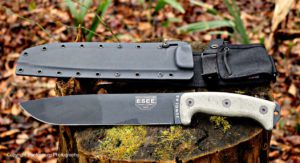
The Junglas and sheath make a lightweight, portable machete setup.
The sheath also locked the knife into place securely. This is the best sheath I’ve tried yet for one of the big knives.
Blade coating: I don’t like blade coatings. In most user knives, the coating does nothing but affect the slicing ability of the blade. But in the swamp conditions and high temperatures and humidity I operate in, rust is sometimes inevitable.
In a machete, in these circumstances, a coating can protect the cutting edge. This becomes important when you’re operating as I was on my creek hike. The knife got pulled out, used, put back in the sheath – sometimes wet – and this happened over and over. The coating doesn’t mean you don’t need to maintain the blade or edge, it just means there is less of a hurry to do so.
On a deer hunt at Delta National Forest in Central Mississippi in early January, the rain was constant. I had the Junglass along, since there was heavy underbrush in the area, and with my luck, I’d end up chopping a path somewhere. The big knife got thoroughly soaked (as did everything else) but the sheath drained well and there was no sign of rust.
Steel: The 1095 high carbon doesn’t have the glamour of the super steels, but it works just fine. 1095 was the standard for knives for years, and I like it a lot. 1095 can do everything a machete steel needs to do. A machete cuts by velocity, and inevitably you will hit dirt or rocks or other unyielding, hard stuff when chopping. A harder steel may chip. The best choice is a softer steel like 1095.
Edge retention: 1095 doesn’t hold an edge as well as some of the tool steels like A2, O1 and etc. It also doesn’t have the price tag of the super steels, and it is a lot easier to sharpen.
When you hit that rock, knot or nail, 1095 will roll, as opposed to chipping as some of the harder steels might. 1095 can be sharpened in the field with a smooth rock, and with minimal effort.
Handle: A big chopper like the Junglass needs a big handle. This handle is large enough that I can get a solid grip on it and long enough to fill my hand. I wear size large gloves, and any tool of mine must have a generous handle.
The best way to chop with a machete, IMHO, is to hold the handle in a pinch grip. This means you grip mainly with your thumb and index finger, and the rest of the fingers are relatively loose. Use a hammer grip, where all the fingers are tightly around the handle, and you’ll develop blisters, tire quickly and transmit the shock all the way up your arm.
The Junglass handle is well-designed for hard work.
Grind: The blade is flat ground with a micro bevel. This works well, and aids in easy sharpening.
Blade thickness: At .188 inches, this is a relatively thin blade, and I suppose it could be broken with enough lateral twisting. Proper machete technique should keep that from happening. The blade bits deeply and chops well.
Do you need a Junglas?
I own several machetes, ranging in price from the $4 blade my daughter bought me as a joke when she was in Nicaragua, to my favorite Bark River machete which lists for more than $200. I use them all as the situation determines. In my big knife collection, the Junglas has seen a lot of use, particularly in the wet swamps. The blade coating and superior sheath means the knife gets carried a lot, and subsequently, gets used a lot.
If you’re looking for a no-frills, hard-working chopping tool that can handle most bushcraft tasks, get a Junglas. You can depend on it.
Please click here to check out and subscribe to the SurvivalCommonSense.com YouTube channel – thanks!
Order your signed copy now!

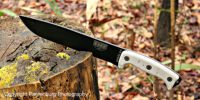
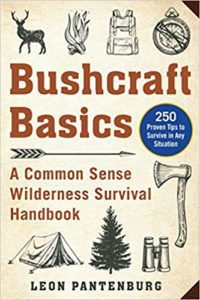
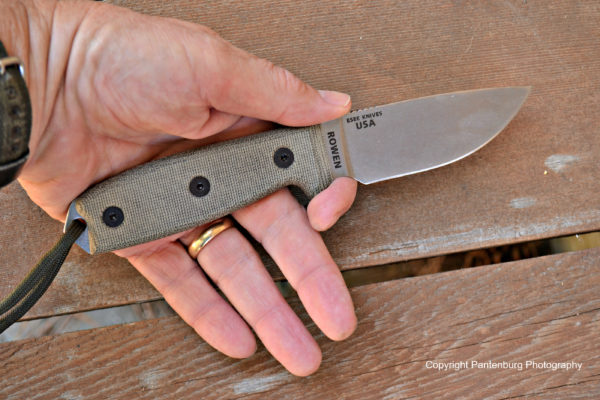
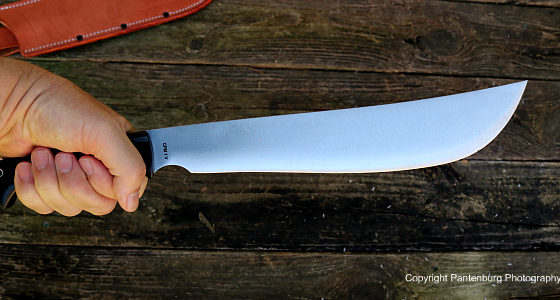
Leave a Reply